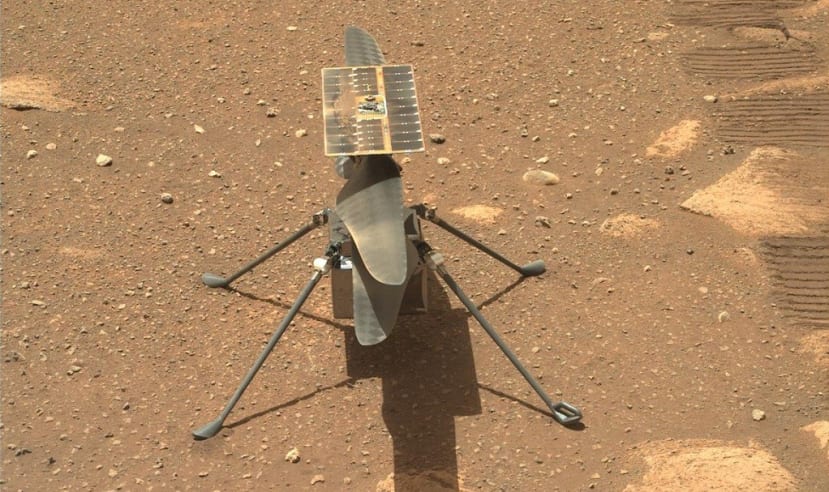Ingenuity: the first aircraft on Mars (that we know of)
Follow articleHow do you feel about this article? Help us to provide better content for you.
Thank you! Your feedback has been received.
There was a problem submitting your feedback, please try again later.
What do you think of this article?
Ingenuity resting on the surface of Mars before its historic first flight. It carries no scientific equipment and acts only as a proof-of-concept demonstrator. Note the wheel tracks of the Perseverance rover on the right.
Image credit: NASA
A real first for NASA this time: an aircraft built on Earth has flown on another planet, Mars. Ingenuity may be tiny, but its flight today means that planetary exploration by ‘drone’ has arrived. For planets with an atmosphere, at least.
A False Start
On April 9th Ingenuity demonstrated that its rotors were able to spin, after which engineers commanded the helicopter’s computers to transition from ‘pre-flight’ to ‘flight’ mode. A software glitch prevented this from happening, causing a watchdog timer to time-out and shut everything down. ‘Watchdogs’ are frequently used in situations like this, where no human operator is around to force recovery by pressing a reset button! After a successful software upgrade, Ingenuity was slated for its first test flight on April 19th.
Making History
As landmarks in the history of human technological endeavour go, this event was never going to get the heart racing: an unmanned drone lifting off from the Martian surface hardly competes with the Apollo 11 moon landing of 1969 or even the ‘Seven Minutes of Terror’ experienced by the controllers watching the Curiosity rover arrive in 2012. Nevertheless, the enforced wait for a response from Mars signalling success, while just boring for us, must have been excruciating for the engineers and scientists at JPL and elsewhere who’ve invested years in the project. You get a feeling for the vast distances in Space when you realise that radio waves travelling at the speed of light take such a long time just to reach our planet from Mars. The communication ‘latency’ also requires robotic explorers to have full autonomous control – no human drone pilots with real-time joystick control here. Confirmation of a successful first flight of just a few seconds hovering at an altitude of 3m came from the telemetry:
Success! The first evidence of an aircraft flight on another world. Note the time scale measured in terms of a system clock, SCLK.
Image credit: NASA
After the telemetry came the first pictures from both Ingenuity and cameras mounted on the rover Perseverance. The pictures took quite a while to arrive, partly due to the slow data rate and partly because of the signal routing via orbiting spacecraft.
The soon-to-be-iconic image from Ingenuity’s downward-pointing camera of its own shadow on the ground 3m below.
Image credit: NASA
What now?
A succession of increasingly adventurous flights are scheduled to take place in the coming weeks. Nothing much in the way of scientific data gathering is planned: the primary objective is to confirm the value of such a machine in exploring planets and moons – those with suitable atmospheres of course. Potentially, robotic aircraft, not necessarily helicopters, can see better than orbiting satellites and are able to traverse rough terrain impassable to ground-based rovers. Meanwhile, we should soon be looking at pictures of Mars taken from an entirely different angle.
The official NASA press kit for Ingenuity provides a wealth of technical and mission detail and is well worth downloading.
If you're stuck for something to do, follow my posts on Twitter. I link to interesting articles on new electronics and related technologies, retweeting posts I spot about robots, space exploration, and other issues.




